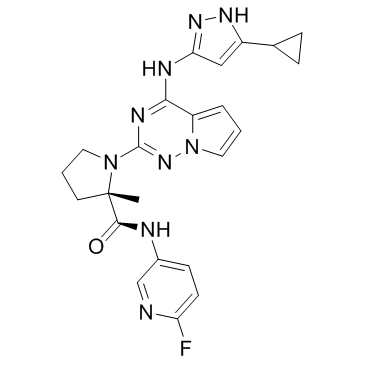| Description |
BMS-754807 is a potent and reversible inhibitor of the insulin-like growth factor 1 receptor (IGF-1R)/insulin receptor family kinases (IR) with IC50 of 1.8 and 1.7 nM, respectively and Ki of <2 nM for both, and also shows potent activities against Met, RON, TrkA, TrkB, AurA, and AurB with IC50 values of 6, 44, 7, 4, 9, and 25 nM, respectively.
|
| Related Catalog |
|
| Target |
IC50: 1.7 nM (insulin receptor), 1.8 nM (IGF-1R), 4 nM (TrkB), 6 nM (Met), 7 nM (TrkA), 9 nM (AurA), 25 nM (AurB), 44 nM (RON)[1]
|
| In Vitro |
BMS-754807 effectively inhibits the growth of a broad range of human tumor cell lines with IC50 values of ranging from 5 to 365 nM. BMS-754807 also inhibits the proliferation of human rhabdomyosarcoma tumor cells Rh41 and human colon carcinoma Geo with IC50s of 7 and 5 nM, respectively. BMS-754807 shows inhibitory activity in the proliferation of Rh41 cells with IC50 of 5 nM[1]. BMS-754807 inhibits the phosphorylation of IGF-1R (IC50=13 nM) and the downstream targets Akt (IC50=22 nM) and MAPK (IC50=13 nM) in the IGF-Sal cell line with IC50 consistent with the antiproliferative IC50 (7 nM) in this cell line[2]. BMS-754807 shows a median EC50 value of 0.62 μM against the PPTP cell lines. The median EC50 for the four Ewing sarcoma cell lines is less than that for the remaining PPTP cell lines (0.19 μM vs. 0.78 μM, P=0.0470)[3]. BMS-754807 (0.25 and 0.5 μM) reduces the activated IGF-IR/IR (pIGF-IR/IR), causes a concurrent decrease in phosphorylated AKT in both lung cancer cell lines. BMS-754807 (0.5 μM) also reduces wound closure of lung cancer cells and reduces the ERK phosphorylation. BMS-754807 reduces cell viability in both A549 and NCI-H358 cells, with IC50 of 1.08 μM and 76 μM, respectively[4].
|
| In Vivo |
BMS-754807 (3.125 and 12.5 mg/kg, p.o.) inhibits tumor growth in IGF-1R-Sal tumor-bearing nude mice. BMS-754807 inhibits tumor growth in a selected group of epithelial (IGF-1R-Sal, GEO, and Colo205), hematopoietic (JJN3), and mesenchymal (RD1 and Rh41) xenograft tumor models with TGI ranging from 53% to 115%. BMS-754807 is effective at a dose level of 3.125 mg/kg twice daily and as low as 6.25 mg/kg once daily, in the highly sensitive Rh41 rhabdomyosarcoma. BMS-754807 (25 mg/kg) also shows synergy when combined with targeted agents in human tumor cell lines and human xenograft models[1]. Furthmore, BMS-754807 is active at doses from 3 mg/kg upward in the IGF-Sal tumor model[2]. BMS-754807 (25 mg/kg, p.o.) induces significant differences in EFS distribution compared to controls in 18 of 32 evaluable solid tumor xenografts (56%) tested, but in none of the ALL xenografts studied[3].
|
| Cell Assay |
Cells are grown at their optimal density in RPMI+GlutaMax supplemented with 10% heat-inactivated fetal bovine serum (FBS), 10 mM Hepes, penicillin, and streptomycin. Cell proliferation is evaluated by incorporation of 3H-thymidine into DNA after exposure of cells to BMS-754807 for 72 h. Results are expressed as an IC50, which is the drug concentration required to inhibit cell proliferation by 50% compared with untreated control cells.
|
| Animal Admin |
The required numbers of animals needed to detect a meaningful response are pooled at the start of the experiment and each is given a subcutaneous implant of a tumor fragment (appr 20 mg) with a 13-gauge trocar. Tumors are allowed to grow to the predetermined size window (75-200 mg; tumors outside the range are excluded), and animals are evenly distributed to various treatment and control groups. There are typically eight mice per treatment and control groups, with the exception of experiments conducted in the Sal-IGF (same as IGF-1R-Sal) tumor model, in which there are typically five mice per treatment and control group. Treatment of each animal is based on individual body weight. Treated animals are checked daily for treatment-related toxicity/mortality. Each group of animals is weighed before the initiation of treatment (Wt1) and then again following the last treatment dose (Wt2). The difference in body weight (Wt2 − Wt1) provides a measure of treatment-related toxicity.
|
| References |
[1]. Carboni JM, et al. BMS-754807, a small molecule inhibitor of insulin-like growth factor-1R/IR. Mol Cancer Ther, 2009, 8(12), 3341-3349. [2]. Wittman MD, et al. Discovery of a 2,4-disubstituted pyrrolo[1,2-f][1,2,4]triazine inhibitor (BMS-754807) of insulin-like growth factor receptor (IGF-1R) kinase in clinical development. J Med Chem, 2009, 52(23), 7360-7363. [3]. Kolb EA, et al. Initial testing (stage 1) of the IGF-1 receptor inhibitor BMS-754807 by the pediatric preclinical testing program. Pediatr Blood Cancer, 2011, 56(4), 595-603. [4]. Franks SE, et al. BMS-754807 is cytotoxic to non-small cell lung cancer cells and enhances the effects of platinum chemotherapeutics in the human lung cancer cell line A549. BMC Res Notes. 2016 Mar 1;9:134.
|
